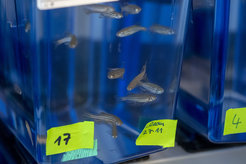Animal experiments at the Max Planck Institute for Infection Biology in 2022
April 24 is World Day For Laboratory Animals. This year, we are again taking the day as an opportunity to publish the animal experimentation figures of the Max Planck Institute for Infection Biology.

At the Max Planck Institute for Infection Biology (MPIIB), researchers conduct animal experiments on mice, rats, and zebrafish. With these experiments, scientists investigate fundamental mechanisms of infections and our immune system.
In 2022, a total of 1351 animals were used in experiments at MPIIB, approximately 13% more than the previous year. This increase is due to a higher use of zebrafish in research, while the number of rats and mice used decreased compared to the previous year. An increase in the number of zebrafish experiments in 2022 was already anticipated as the research group In Vivo Cell Biology of Infection, established in 2020, expanded its work.

After COVID-19, tuberculosis is the leading cause of death by a single infectious organism. In the research group In Vivo Cell Biology of Infection, scientists study tuberculosis granulomas—nodular collections of immune cells that form around tuberculosis bacteria. These cell clusters are designed to encapsulate infected cells and prevent further spread of the pathogens. However, in the case of tuberculosis, these structures also limit the ability of the immune system and antibiotics to reach the bacteria contained within them.
In humans, these granulomas typically form in the lungs. While zebrafish lack lungs, fish form granulomas that closely resemble human tuberculosis granulomas. Using the zebrafish model, tuberculosis researchers have been able to answer a number of long-standing questions about the granuloma and tuberculosis infection that have furthered our understanding and therapy of tuberculosis in human patients.
For research at the Max Planck Institute for Infection Biology in 2021, preliminary genotyping experiments were conducted on zebrafish—a technique that allows researchers to study the composition of the genetic material. These experiments involve little stress to the animals. Then, in 2022, the first medium-stress infection experiments were conducted. In these, zebrafish were infected with the fish-specific pathogen Mycobacterium marinum, a close relative of tuberculosis that it used to model this disease in fish.

For a detailed explanation of stress levels in animal experiments, including the legal requirements and examples of stress levels, see the page of the Initiative Tierversuche Verstehen.
Animal experiments are still indispensable in biomedical research—also at the Max Planck Institute for Infection Biology. They represent an important part of the experimental method spectrum, especially for research on the complex mechanisms of our immune system.
Even if the development of alternative methods is progressing steadily and some animal experiments can now be replaced or reduced—a complete replacement of animal experiments is not currently foreseeable.


